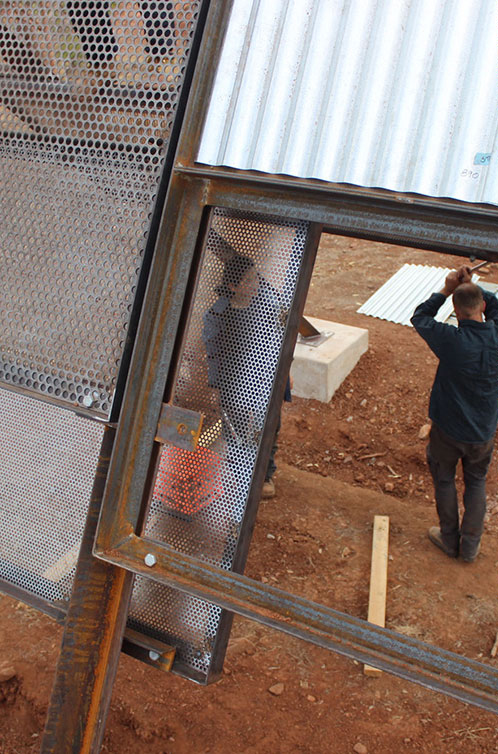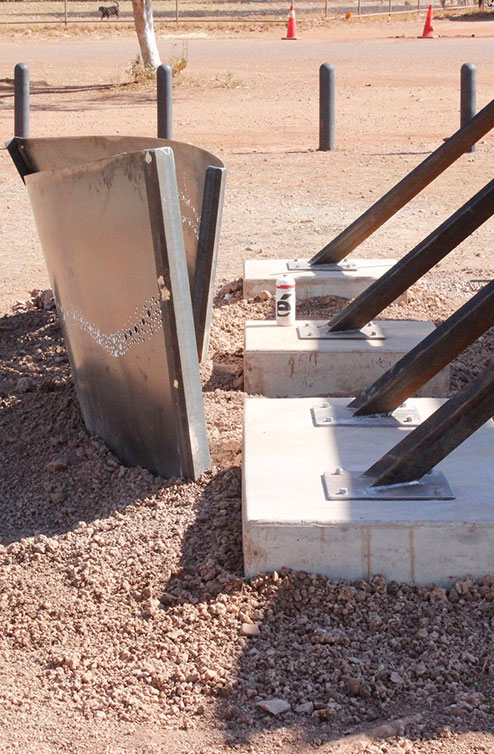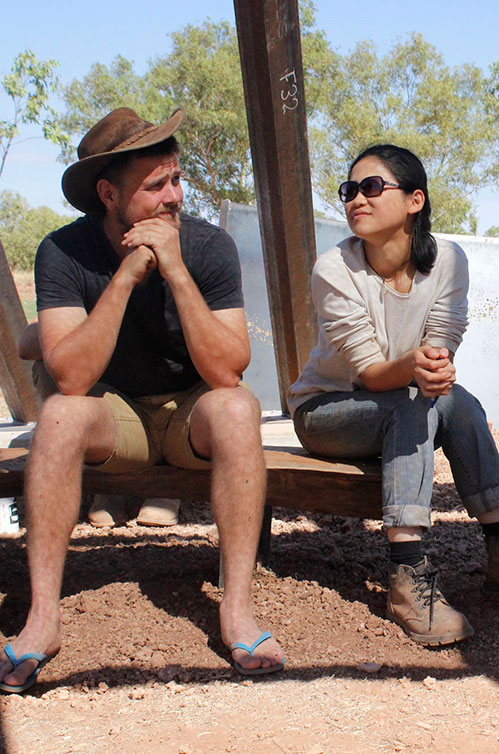Wave Hill ‘bough shelter’ pavilions
- Location: Jinbarak, Junardi and Kalkaringi Northern Territory
- Completed: June 2016 (on time and within budget)
- Awarded: 2016 Yali-McNamara Award, Australian Institute of Architects
- Exhibited: 2018 Venice Architecture Biennale
- Featured: 2022 in Gunyah, Goondie + Wurley: The Aboriginal Architecture of Australia, Paul Memmott
Fifty years ago one of the most important events ever to take place in Australia occurred on a remote cattle station at Wave Hill in the Northern Territory.
Lord Vesty, living in London, refused to pay the Aboriginal stockmen and farm workers their rightful wages. He had stolen their land. The workers and their families, led by Vincent Lingiari, left the station along the ‘walk-off’ track.
After a strike lasting more than eight years the Australian Government accepted the Gurindji’s claims for equal wages and allocated a portion of their land back. At a ceremony in 1975 Australia’s Prime Minister, Gough Whitlam, symbolically poured a handful of sand into Vincent Lingiari’s hands as he passed ownership back to the Gurindji people. This was the first successful land rights case for Australia’s First People.
The walk-off remains widely celebrated at the Kalkaringi and Dagaragu communities each August with visitors and media coming from all around Australia. This year is the 50th Freedom Day celebration and Bower Studio was invited by the Gurindji people to help commemorate the 50th Freedom Day with a series of ‘bough shelters’ along the walk-off track and at the town’s cultural hub.
Bower Studio staff and graduate students liaised and worked with the community over a two-year period to secure funding and industry support to realize their broader aspirations.
During the first phase three bough shelters were designed and completed in June 2016. The community provided its input and the design team included students who had completed a range of previous Bower Studio programs.
The bough shelter’s designs were driven in part by the stories told by the community elders and traditional owners during consultation visits as well as a series of remnant artifacts from the Wave Hill Station held in esteem by the elders. Each of the shelters along the track use the same language but is unique to its specific site and the stories belonging to that site.
Over a two week period a combined team of students and community workers assembled a giant ‘meccano set’ of prefabricated steel ribs and panels, fitted seating and installed landscaping elements.
The first bough shelter was constructed at the Wave Hill Station (also known as Jinbarak) where Vincent Lingiari led the walk-off. The second was built at Gordy Creek (Junardi) where the strikers and families collected water to continue their journey. The third shelter was located in the arts precinct at Kalkaringi close to the existing arts center located in an abandoned power station.
The 2016 Freedom Day celebrates the 50th anniversary of the walk-off and with so many attendees and influential visitors it offers an ideal opportunity for the community to seek support for the new arts and culture facilities.
The Kalkaringi school is hosting an exhibition of community artworks and is working with the arts center to display the community’s ideas and aspirations for the proposed arts and culture building/s. The Bower Studio team has been invited to work with the community to produce a series of designs to provoke discussions about the most appropriate architectural response.
The Wave Hill Walk Off Bower Studio has been featured across Australian media around the anniversary in August 2016. Highlights include 774 ABC Melbourne Breakfast with Red Symons, Radio Larrakia and ABC Mornings in Darwin, and Radio 2TM and 2SM in New South Wales.

Indigenous memory-making meets architecture
The Wave Hill walk-off changed the course of Australian history, yet the event suffers from a lack of recognition. Now, architects have become its unlikely champion.
Sponsors

Community Partners
- Gurindji Aboriginal Corporation
- Gurindji Language Centre
With support from the board members from these organisations.
Community Leaders
- Paddy Doolak
- Topsy Dodd
- Jimmy Wave Hill
- Biddy Wave Hill
- Phillip Jimmy
- Gus George
- Violet Wardrill
- Rob Roy
- Michael George
- Justin Paddy
Community Workers
- Billy Joshua
- Peterson Alec
- Ethan Morris
- Darren Morris
- Nathaniel Jimmy
Studio Leaders
- David O’Brien
- George Stavrias
- James Neil
- Ilari Lehtonen
- Mia Hutson
- Jack Hinkson
With support from Professor Aaron Corn (Center for Aboriginal Studies U.Tas), Lyndon Ormond-Parker (Melbourne School of Population and Global Health), James Danatzis & Laura Cantrell (Arup) and Allison Stout (NBC Broome).
Students
- James Connor
- Sarah Fraraccio
- Jinwoo Jung
- Olof Klintmalm (Aksel)
- Justin Milesi
- Xeyiing Ng
- Camilla Paradice
- Dan Smith
- Nina Tory-Henderson
- Toby Woolley
- Esther Ziebell
Special Thanks
- Phil Smith
- Penny Smith







































